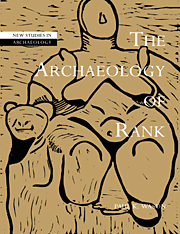Book contents
- Frontmatter
- Contents
- List of figures and tables
- Acknowledgments
- 1 The present study of past society
- 2 Social theory and social life: models of society in the archaeological study of status
- 3 Inequality and social life: a working model
- 4 Mortuary data as evidence of ranking, Part 1
- 5 Mortuary data as evidence of ranking, Part 2
- 6 The form and distribution of artifacts
- 7 Status, settlements, and structures
- 8 Çatal Hüyük: a ranked Neolithic town in Anatolia?
- Notes
- References
- Index
- NEW STUDIES IN ARCHAEOLOGY
6 - The form and distribution of artifacts
Published online by Cambridge University Press: 22 August 2009
- Frontmatter
- Contents
- List of figures and tables
- Acknowledgments
- 1 The present study of past society
- 2 Social theory and social life: models of society in the archaeological study of status
- 3 Inequality and social life: a working model
- 4 Mortuary data as evidence of ranking, Part 1
- 5 Mortuary data as evidence of ranking, Part 2
- 6 The form and distribution of artifacts
- 7 Status, settlements, and structures
- 8 Çatal Hüyük: a ranked Neolithic town in Anatolia?
- Notes
- References
- Index
- NEW STUDIES IN ARCHAEOLOGY
Summary
From archaeology's beginnings, indeed from well before the study of antiquities attained the rigor implied by the term, artifacts have been central to our understanding of the prehistoric past. Using mobile products of human activity to infer status is also a time-honored practice. One basic approach attempts to infer inequality from the presence (and quantity when possible), of certain items in the assemblage, a line of reasoning that depends on our ability to recognize status, elite, or wealth items apart from a distributional context. Another basic approach makes use of the unequal distribution of artifacts in such contexts as burials, hoards, residences, and regions. This chapter covers two additional topics because they relate more to artifacts than burials or architecture: iconography and the inference of stratification. Further approaches to distinguishing stratified from non-stratified ranking are elaborated in the next chapter.
Status markers: elite goods and sumptuary items
Is it possible to show that something was a status item apart from distributional context, and so infer ranking from its presence alone? Hodder is certainly correct in saying that “to look at objects by themselves is really not archaeology at all,” that material objects alone are mute and it is context that provides clues to their meaning (1991b:4). But while Hodder has in mind the traditional view of an artifact's context – the spatial associations of careful excavation – I suggest that knowledge of how items are used among other people constitutes an alternative context appropriate for drawing inferences from artifacts.
- Type
- Chapter
- Information
- The Archaeology of Rank , pp. 103 - 126Publisher: Cambridge University PressPrint publication year: 1994
- 1
- Cited by



